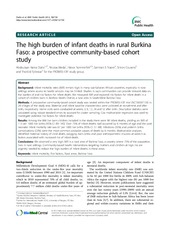| dc.contributor.author | Diallo, Abdoulaye Hama | en_US |
| dc.contributor.author | Meda, Nicolas | en_US |
| dc.contributor.author | Sommerfelt, Halvor | en_US |
| dc.contributor.author | Traore, Germain S. | en_US |
| dc.contributor.author | Cousens, Simon | en_US |
| dc.contributor.author | Tylleskär, Thorkild | en_US |
| dc.date.accessioned | 2013-01-21T09:20:01Z | |
| dc.date.available | 2013-01-21T09:20:01Z | |
| dc.date.issued | 2012-09-05 | eng |
| dc.Published | BMC Public Health 2012, 12:739 | eng |
| dc.identifier.issn | 1471-2458 | |
| dc.identifier.uri | https://hdl.handle.net/1956/6280 | |
| dc.description.abstract | Background: Infant mortality rates (IMR) remain high in many sub-Saharan African countries, especially in rural settings where access to health services may be limited. Studies in such communities can provide relevant data on the burden of and risk factors for infant death. We measured IMR and explored risk factors for infant death in a cohort of children born in Banfora Health District, a rural area in South-West Burkina Faso. Methods: A prospective community-based cohort study was nested within the PROMISE-EBF trial (NCT00397150) in 24 villages of the study area. Maternal and infant baseline characteristics were collected at recruitment and after birth, respectively. Home visits were conducted at weeks 3, 6, 12, 24 and 52 after birth. Descriptive statistics were calculated using robust standard errors to account for cluster sampling. Cox multivariable regression was used to investigate potential risk factors for infant death. Results: Among the 866 live born children included in the study there were 98 infant deaths, yielding an IMR of 113 per 1000 live births (95% CI: 89–143). Over 75% of infant deaths had occurred by 6 months of age and the post neonatal infant mortality rate was 67 per 1000 live births (95% CI: 51–88). Infections (35%) and preterm births complications (23%) were the most common probable causes of death by 6 months. Multivariable analyses identified maternal history of child death, polygyny, twin births and poor anthropometric z-scores at week-3 as factors associated with increased risk of infant death. Conclusions: We observed a very high IMR in a rural area of Burkina Faso, a country where 75% of the population lives in rural settings. Community-based health interventions targeting mothers and children at high risk are urgently needed to reduce the high burden of infant deaths in these areas. | en_US |
| dc.language.iso | eng | eng |
| dc.publisher | BioMed Central | eng |
| dc.relation.ispartof | <a href="http://hdl.handle.net/1956/6281" target="blank">Perinatal and infant mortality in rural Burkina Faso. A prospective community-based cohort study</a> | eng |
| dc.rights | Attribution CC BY | eng |
| dc.rights.uri | http://creativecommons.org/licenses/by/2.0 | eng |
| dc.title | The high burden of infant deaths in rural Burkina Faso: a prospective community-based cohort study | en_US |
| dc.type | Peer reviewed | |
| dc.type | Journal article | |
| dc.description.version | publishedVersion | en_US |
| dc.rights.holder | Copyright 2012 Diallo et al.; licensee BioMed Central Ltd. | |
| dc.identifier.doi | https://doi.org/10.1186/1471-2458-12-739 | |
| dc.identifier.cristin | 996728 | |

